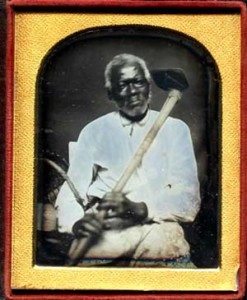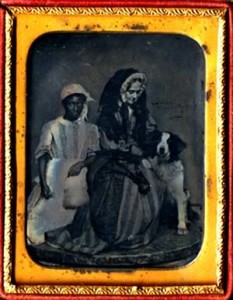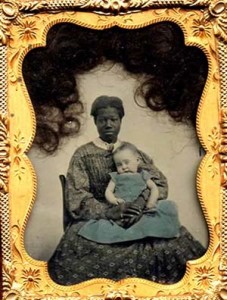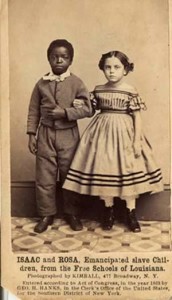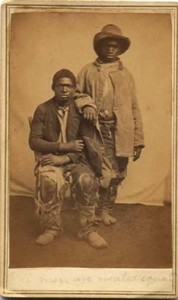Man is the only picture-making animal in the world. He alone of all the inhabitants of the earth has the capacity and passion for pictures . . . Poets, prophets, and reformers are all picture-makers, and this ability is the secret of their power and achievements: they see what ought to be by the reflection of what is, and endeavor to remove the contradiction.
–Frederick Douglass
In the late summer of 1839, at an extraordinary joint meeting of the Academy of Science and the Academy of Fine Arts in Paris, Louis Jacques Mandé Daguerre presented to the public and to the world the first truly successful photographic process: the daguerreotype. It is hard for us to grasp now, after more than 160 years of photography, the astonishment and enthusiasm that greeted Daguerre’s discovery. On a small plate of metal, Daguerre coaxed the sun’s rays, guided by the lens of a camera, to produce an image whose detail was as minutely faithful to reality as the reflection in a mirror–only in black and white. In an age of soaring expectations of science, the daguerreotype symbolized the possibility that human ingenuity might capture the very essence of nature. The daguerreotype is truly a marvel: strictly speaking, it is impossible to reproduce one, since a daguerreotype image sits on a silver surface that reflects like a mirror; one therefore sees oneself in the image, too. The only way to appreciate a daguerreotype properly is to see it, as it were, in person. This personal intimacy and immediacy lent much of the fervor to what Frederick Douglass called the new “passion for pictures.” While the inventor of the daguerreotype was a Frenchman, nowhere did this passion catch on as it did in the still young United States. For Douglass, the former slave and abolitionist orator, photography, as a mirror of reality, would serve as a new weapon in the fight for freedom and human dignity. Samuel F. B. Morse, the American inventor and painter, happened to be in Paris in 1838-39 to promote his own invention, the electromagnetic telegraph. There he met and befriended Daguerre. Morse tried his hand at the process as soon as Daguerre made it public, and, on his return to the States, he successfully spread word of Daguerre’s genius to his fellow Americans. Scores, then hundreds, and finally thousands of American practitioners took up the art, improving the technique so rapidly that by the early 1840s a skillful daguerreotypist could earn a respectable income as a portraitist. The American public hungered unrelentingly for portraits. Douglass explains this passion well: “The great discoverer of modern times, to whom coming generations will award special homage, will be Daguerre. Morse has brought the seeds of the earth together, and Daguerre has made it a picture gallery. We have pictures, true pictures, of every object which can interest us . . . What was once the special and exclusive luxury of the rich and great is now the privilege of all. The humblest servant girl may now possess a picture of herself such as the wealth of kings could not purchase fifty years ago.” By the 1850s and 1860s, American ingenuity had led to an explosion of photographic techniques including the ambrotype, tintype, and carte de visite–all to feed the endless American appetite for portraits. Tens of millions of images were produced. Once, portraiture had been the “special and exclusive luxury” of the rich or the noble in the form of paintings or sculptures that cost a small fortune to commission; now Americans could assert their egalitarianism in self-representation. For a day’s wages, even a mill worker could confirm her dignity and make her bid for immortality (fig. 2).
As Frederick Douglass saw it, Morse and Daguerre were two facets of the same democratizing revolution, a revolution that was fast uniting the world in communication (Morse) and in image (Daguerre). For Douglass, this universalizing and democratizing revolution involved more than a breaking down of class divisions; it also meant attacking what we might call the optics of racism, that is, how white Europeans had come to see black Africans as a nearly separate species, a view which corrupted painted portraits: “Negroes can never have impartial portraits at the hands of white artists. It seems to us next to impossible for white men to take likenesses of black men, without most grossly exaggerating their distinctive features. And the reason is obvious. Artists, like all other white persons, have adopted a theory respecting the distinctive features of Negro physiognomy.” When Douglass complained about how white artists “take likenesses” of blacks, he meant painters, sculptors, and engravers–all artists except photographers, because in all other art forms, the artist’s preconceived way of seeing necessarily intrudes upon the representation of the subject matter. In voicing this complaint, Douglass echoed a widely held notion about photography, one that persists to this day: that unlike other techniques in art, photography is a true mirror of nature whose method, because it relies on the nonpartisan effectiveness of rays of light rather than the hand of human beings, can present us with what Douglass calls “true pictures” of reality. Many contemporary theorists would now question that assumption. They would claim that photography is more art than science by pointing to how the subject matter is arranged, how the lighting is manipulated, to what type of lens or printing-out paper is employed, even to the way the scene is composed and framed. All these factors play as much of a subjective role in producing and seeing the work of art as does the hand of the artist with a paint brush or a mallet and chisel. The photograph, then, is no more a “true picture” of reality than a cubist painting by Picasso. But, at least for now, let us give Douglass the benefit of the doubt. After all, there is for most of us, in our pre-theoretical experience of photography, something of that experience of immediacy and revelation of reality that so astonished and inspired him, as well as so many other Americans, a century and a half ago.
Douglass was photographed often. One of the very earliest known portraits of him was taken in the mid-1840s, probably just around the time that the publication in 1845 of The Narrative of the Life of Frederick Douglass, an American Slave Written by Himself made Douglass a national and then an international celebrity. This austere portrait of the still youthful Douglass, who meets our gaze so forcefully, epitomizes his hope and expectation that photography might bestow a public dignity upon African Americans that would provide a pictorial argument for their inclusion in the promise of the Declaration of Independence: that the only legitimate government is one that gives support to the self-evident truth that all men are created equal. Many other portraits make the same visual argument, such as this one of an unnamed self-confident horn-player (fig. 4).
With his complicated instrument and sheet music, his portrait proclaims the capacity for refinement and self-cultivation. Or consider this portrait of an unidentified African American woman whose strength and resilience break through the stiff pose of conventional portraiture (fig. 5).
These portraits, and others such as this one of a man holding a book, show sitters who have attained something like middle-class respectability (fig. 6).
Other portraits, such as this 1849 daguerrotype of a man in his work clothes and an apron (fig. 7) or the portrait of a fireman in his gear (fig. 8), illustrate that African American laborers and artisans could also afford to show themselves for who they were, with pride in their trade or their work in public service.
When the Civil War broke out, Douglass lobbied President Lincoln passionately for the right of African Americans to bear arms and fight for the Union cause. “I have a right to ask when I . . . march to the battle field” for “a country or the hope of a country under me, a government that recognizes my manhood around me, and a flag of freedom waving over me!” By 1863, black regiments were forming and young African American men resolutely met the call to arms (fig. 9).
The national struggle over the political meaning of race found expression in all arenas of antebellum visual culture. In The Octoroon, a statue made by John Bell, a naked and apparently “white” woman, her arms in chains, her clothes on the pillar beside her, bows her head in a sorrowful yet dignified resignation to inspection before going to the auction block (fig. 10).
As F. James Davis has explained so well in Who Is Black?, the American categorization of race is unique in the world. By the middle of the nineteenth century, in reaction to the threat of abolition and to the fact of interbreeding between whites and blacks, the United States had developed the so-called “one drop rule,” stipulating that even a single African ancestor was enough to make a person black, not white–and legally a slave if born to a slave mother–no matter how distant that ancestor or how white-looking the subject. The Octoroon offers a challenge to the one drop rule by asking white Americans, Can’t you see that this person, whom the law and social convention treats as a slave and nearly another species from us, is in fact just like us? This same visual argument is made in a Civil War era photograph, “White and Black Slaves” (fig. 11).
The subjects here are liberated slaves from New Orleans–of very different skin color. The force of the title is the notion that the visual marker of skin color makes no sense as an indicator of race–and that, by extension, race itself makes no sense as a concept by which to organize society. “Slaves from New Orleans,” in which a very dark-skinned adult man reads with three lighter-skinned children, makes the same argument again: race and skin tone make no difference to the essential and universal dignity of human beings, all of whom deserve and are capable of education and uplift. Photographs like this can teach us about the fundamental ambiguity of race: it is conventional, not a natural category, but once convention gives race a social reality, race can make a terrible difference (fig. 12).
Some images present difficulties for Douglass’s hope that photography would serve as an unambiguous language of freedom. For example, consider this portrait of a slave from Missouri (fig. 13).
The elderly man has been posed with a hoe, a symbol of his servitude, and a basket of produce at his side. We have to wonder: why did his owner make this portrait? As a mark of affection for this aging slave? As a token of the master’s wealth and success? Other portraits of servants, whether slave or free, also bear witness to a muted strength that speaks at the edges, as it were, of the subject matter of the photograph. The intended subject of this photograph (fig. 14) is obviously the wealthy white woman at the center; she or her family has paid for this portrait, and she has come with her dog and her servant to demonstrate her genteel status. The woman’s attention is focused on the dog, not the person directly beside her, and yet it is the servant who meets our eye and makes human contact, a connection that her mistress refuses to her.
Something similar takes place in this antebellum “nanny portrait,” in which the intended subject is the white child, and the client includes the family’s black slave or servant to indicate a class status: we are rich enough to afford this nanny (fig. 15).
Here, the young nanny (possibly a slave, possibly a servant) meets our gaze. Her demeanor, with her hands folded protectively across the squirming toddler in her lap, is not one of defiance but rather of reserved supportiveness. But what do we make of the extraordinary element of the human hair sealed under the glass, between the brass mat and the image, arranged as a kind of halo around the two figures? Perhaps it is the child’s, but it has the texture of an adult’s hair rather than the wisps of a toddler. If the hair is the nanny’s, then, that surely indicates the important place she held in the family, however subordinate. Three images from the Civil War era illustrate the national debate over the line between black and white (figs. 16, 17, 18).
All are cartes de visite, the products of a photographic process that allowed for mass reproduction, whether for sale at a profit or for raising charitable funds. Printed text on the reverse of the first two cards–of the branded slave, Wilson Chinn, and of the emancipated children, Isaac and Rosa–reads: “The proceeds from the sale of these Photographs will be devoted exclusively to the education of colored people in the Department of the Gulf, now under the command of Major-General Banks.” These two cards represent one contemporary interpretation of the goals of the war: on the one hand, to end the outrage of slavery perpetrated on men like Wilson Chinn (who is, by the way, the same Wilson as in Figure 12), and, on the other, to right an historical injustice by giving the liberated slaves a future as productive citizens of the nation. The third image is more ambiguous. No maker takes credit for it, as the photographer Kimball does on the other two. The photograph depicts two youths in horrendously tattered rags. They are almost certainly contrabands–slaves who have taken the opportunity of war to escape from their masters to seek refuge with the advancing Union armies. Beneath the portrait someone has written in pencil, “All men are created equal.” This direct quotation from the Declaration of Independence seems to support the abolitionist position on the war–until one turns the card over and reads further: “This is not exaggerated in the least — : not one out of ten of the niggers here, who have run away from their masters (and there are thousands of them) can boast of such good clothes. Shove them into the army, I say, and let them do the fighting in this hot Department.” This was probably written by a Union soldier who bought the card at the front from a camp merchant and sent it home in the mail. His caption about “all men” being created equal is at best darkly ironic; he clearly refuses to accept equality with these unfortunates, thereby repudiating the idealistic interpretation of the American founding as truly universalistic. While Frederick Douglass wanted former slaves to fight to affirm and confirm their dignity and equality as citizens, this anonymous writer wants them to fight purely because he sees them as expendable–and precisely because he deems them beneath human dignity. This is the tragic and enduring contradiction of race as represented in antebellum photographs: the same image can arouse at once pity and righteous indignation or contempt and arrogant dismissal. Perhaps it is too much to ask for an image alone to conquer the prejudices that we bring to bear in our seeing. Consider this tintype produced around the end of the Civil War period: it depicts a grinning white man in blackface (fig. 19).
Although the Jim Crow character as a feature of minstrel shows became popular in the generation before the Civil War, early photographic images of people in blackface are quite rare. Of course, minstrelsy “sees” the darkness of the African complexion. But by appropriating that complexion and superimposing it upon a white face–whose whiteness the viewer is never really meant to forget–all the participants in the performance of minstrelsy, both actors and viewers alike, attempt to make invisible the human dignity of the truly black faces who share their world and whose presence calls out for equality. The Civil War ended slavery, as Douglass had hoped, but Reconstruction failed to give former slaves the civic equality that Douglass believed the Declaration of Independence required as due to all human beings. Instead, there descended the long night of Jim Crow segregation, enforced by the terror of lynching. Was Frederick Douglass naive to hope for a revelation of human dignity from photography? Only if we believe that the failures of the past must be our failures, too. We can look carefully at these portraits. We can search in them for the echoes of human presence. We can affirm, celebrate, and restore the hidden, the neglected, and the anonymous. In this way, their past can be our present. And our future. Douglass said that we can “see what ought to be by the reflection of what is, and endeavor to remove the contradiction,” and surely it is not too late for idealism like that. We are still the picture-making animal that can envision a future by seeing the present clearly in reflection on the past. The author wishes to thank his colleague and friend, Greg French, for permission to employ so many images from his collection in writing this essay.
Further Reading: See F. James Davis, Who Is Black? One Nation’s Definition (University Park, Pa., 1991); Frederick Douglass, “Life Pictures,” holograph dated 1861, in The Frederick Douglass Papers, Library of Congress, microfilm accession no. 16377, reel 14, frames 394-412; Frederick Douglass, “Pictures and Progress,” in John W. Blassingame, ed., The Frederick Douglass Papers, ser. 1, vol. 3 (New Haven, 1979-92); Merry A. Forresta and John Wood, eds., Secrets of the Dark Chamber: The Art of the American Daguerreotype (Washington, D.C., 1995); O. Henry Mace, Collectors’ Guide to Early Photographs, 2d ed. (Iola, Wis., 1999); Eric Lott, Love and Theft: Blackface Minstrelsy and the American Working Class (New York, 1993); Beaumont Newhall, The Daguerreotype in America, 3d ed. (New York, 1976) and The History of Photography, 5th ed. (New York, 1994); John Stauffer, “Race and Contemporary Photography: Willie Robert Middlebrook and the Legacy of Frederick Douglass,” in John Wood, ed., The Journal of Contemporary Photography: Culture and Criticism(Brewster, Mass., n.d.); Colin Westerbeck, “Frederick Douglass Chooses His Moment” in Susan F. Rossen, ed., African Americans in Art (Chicago, 1999).
This article originally appeared in issue 2.2 (January, 2002).
Gregory Fried is an assistant professor in the philosophy department of California State University, Los Angeles. He has written on the work of the philosopher Martin Heidegger, and is currently working on a multidisciplinary project on race entitled “The Mirror of Race.”



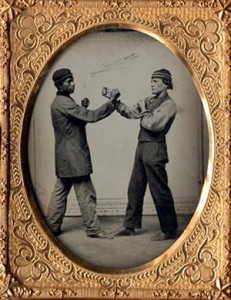
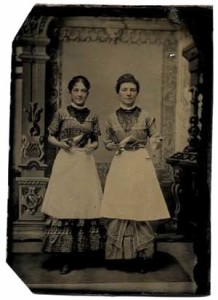
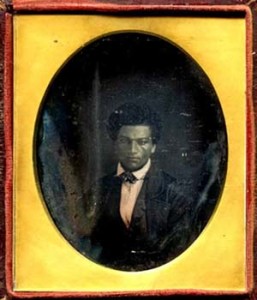
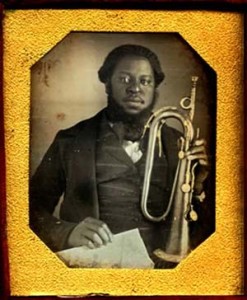
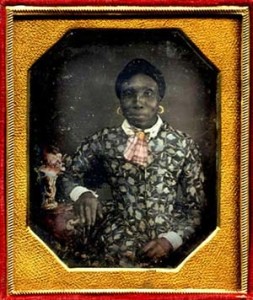
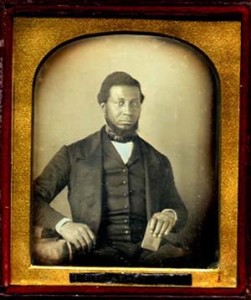
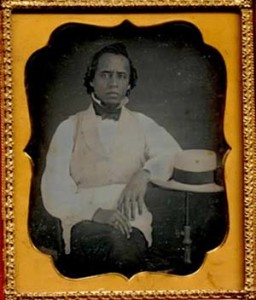



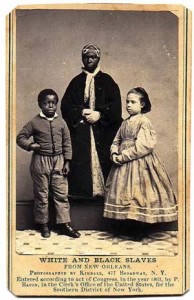
![Fig. 12. Photographer unknown: Wilson [Chinn], Charley, Rebecca, and Rosa ("Learning Is Wealth"), carte de visite, c. 1863. Collection of Greg French.](https://commonplace.online/wp-content/uploads/2015/09/2.2.Fried_.12-181x300.jpg)
